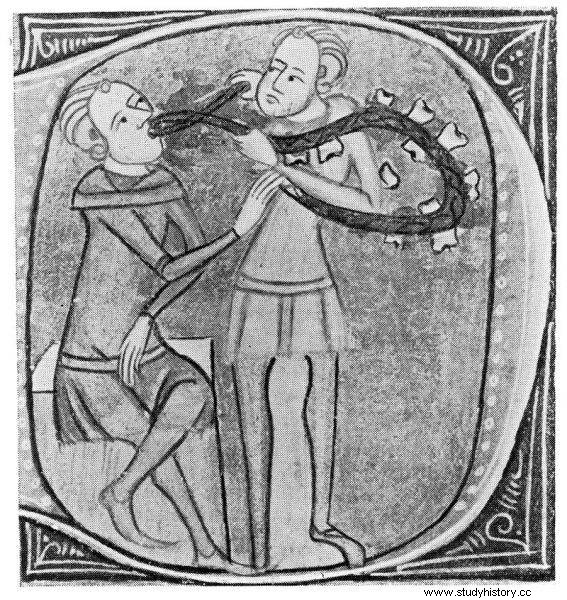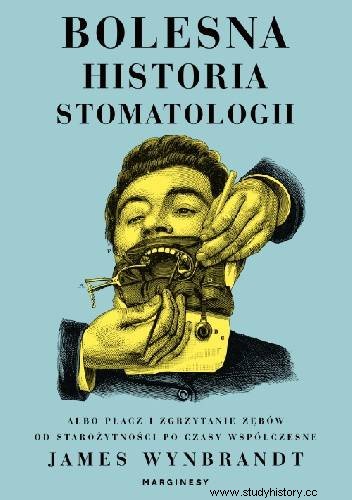Horror? Understatement! Broken skull bones, hemorrhages, sepsis, and even death - that was how often visits to medieval "dentists" ended. It is not surprising that the people of that time avoided tooth specialists with a wide berth ...
The deafening sound of the trumpet calls for the chatter to gather in the market square in front of the stage. The talking monkey sitting on the dais carefully watches the crowd from under the umbrella, while the juggler performs various tricks and makes dirty jokes to keep the audience warm.
After a while, the juggler ends the performance, the music stops and the imposing figure of a man dressed in an expensive tunic rushes onto the stage. On his head is a stately hat decorated with feathers, and a necklace of human teeth glitters on his chest. His boastful oration soon draws the initially reluctant victim of toothache to the scene. After a few moments it is all over:the troublesome tooth is extracted quickly and painlessly.
The volunteer looks in amazement at his savior, who, to the delight of the public, holds the tooth high. At this point, other unfortunates suffering from similar ailments move towards the stage to put themselves in the hands of the snatch. It is unlikely, however, that everyone waiting in their turn will experience the same painless extraction as the accomplice of a home-grown dentist who has just impressively acted out the tooth extraction scene.
The roar of the horn and the rumble of drums effectively drown out the screams of patients. Before the sepsis attacks the body or other life-threatening complications resulting from the imposter's incompetence make themselves known, he will not be in the town for a long time. This is what a visit to the dentist in medieval times was like.
Haemorrhages and other "unpleasant events"
Of course, there were other possibilities. A person with toothache could use the services of a barber who performed the extraction or performed an alternative, less invasive procedure such as bleeding. Or she could choose from a range of completely useless potions sold as immediate remedies for all kinds of dental ailments.
Unfortunately, the renowned medical practitioners who worked part-time dentistry in ancient Rome left the battlefield with the fall of the empire, leaving the art of treating teeth to ignorant ignorant people, morons and charlatans.

A visit to a tooth-ragged catcher was treated as a last resort
The reluctance of doctors to practice dentistry seems understandable, because the possibilities offered by contemporary medicine, both in terms of relieving toothache and treating its causes, were limited. Despite the wisdom preached by Hippocrates and his contemporaries, oral well-being was viewed as an undignified occupation by professional medics in the ancient world and this belief persisted throughout the Middle Ages.
Back in the 16th century, the Swiss professor of medicine Theodor Zwinger advised doctors not to perform the extraction, arguing that it was best to leave it to barbers and other healers, as the procedure often resulted in "unpleasant accidents" resulting in broken jaw bones, injured gums and severe bleeding. More than a hundred years later, the famous Dutch physician Kornelis van Solingen also expressed his contempt about dental surgery.
Medications from a medieval pharmacy
Just as doctors had good reason to turn their backs on dentistry, there was no shortage of reasons for ordinary citizens to stay away from tooth rattles and their colleagues. Due to the pain and high level of risk of their procedures, they were only seen as a last resort.
People went out of their way to avoid visiting these pseudodentists. In desperation, they reached for completely ineffective or even dangerous mixtures, tinctures and lotions, which significantly contributed to the flourishing of the pharmacological market. A symbol of this prosperity was the opening of the first pharmacy in England in 1345. It's hard not to wonder what this event looked like at a time when the media system was not as developed as it is today.
Painkillers for all dental ailments were probably on the list of drugs available at the pharmacy. In the section dedicated to the toothworm, you might have purchased typical medieval medicaments:honey, bitter herbs, myrrh, aloe, colloquint, and acids such as pig's gastric juice.
Find out more:How to torture and then ... heal? Medieval rehabilitation after visiting the torture chamber
Fighting the toothworm
13th-century manuscript of Leechdoms, Wortcunning and Starcraft [ Medicine, natural remedies and astrology - approximate translation of the title] contains many references to diseases of the oral cavity and a collection of folk remedies used to combat toothache, which clearly echo the erroneous information recorded by quack surgeons of that time.
To get rid of the tooth worm, take an equal measure of henbane seeds, acorn flour and wax, mix all the ingredients, make a candle out of them, set it on fire and smoke the inside of the mouth , then place the black material on it and wait for the worms to fall onto it.

The Turkish image of a toothworm.
To get rid of a toothache that is hollowed out by a worm, take a holly, a sage and a sage, boil them in water, pour the decoction into a bowl, then lean over it and start yawn. Then the worms will fall into the dish.
To get rid of toothache, wipe the bark of the thorn wood and hazel, make an incision in the outer wall of the tooth and sprinkle the powder regularly on it.
For upper tooth pain, take the fracture leaves, roll them up and squeeze the juice straight onto the nose. For lower pain, cut the gums with a sharp instrument until they start to bleed.
In case the tooth could not be saved, the creator of the manuscript also included a recipe for painless extraction:
Take a few newts, some call it lizards, and a handful of those nasty beetles you can come across among the ferns in summer. Roast them in an iron cauldron, and then make a powder of them. Moisten the index finger of your right hand, dip it in the powder, and then rub it into the tooth. Repeat this action many times, refraining from spitting, until the tooth falls out painlessly. The effectiveness of this method has been confirmed.
Pain relief dung
In the 15th-century "book of leeches", a hirudotherapy instructional manual, we can find descriptions of similar treatments. One of them is to be a remedy for "toothache":
Take raven dung and stain it with bertram juice so that the patient won't recognize what it is, place it in a hole with a tooth. Then, as the story goes, this dung will burst the tooth from the inside, the pain will pass and the tooth will fall out.
If none of the above methods helped, there were a lot of non-extractive procedures such as bloodletting, leech treatment, skin burning, enemas, cupping, garlic cloves in the ears, cauterizing the nerves inside the tooth with hot iron or strong acid .

The text is an excerpt from the book by James Wynbrandt The Painful History of Dentistry, or the Crying and Grinding of Teeth from Antiquity to the Present, which has just been published by Marginesy Publishing House.
If someone decided to visit the ragweed, he probably suffered terrible torments, and his tooth was visible in such a condition that it could only be removed. On the other hand, whether the patient would get rid of the correct tooth and whether he would survive at all was an open question (...).See also:A loved one's excrement for a broken heart, burning with iron against melancholy. The stupidest drugs in the history of medicine
Touring toothbrushes
There are many indications that the most severely criticized medics, i.e. tooth raggers, met with hostility that can be seen even from the numerous synonyms of their profession. The most frequently used terms were:quack, quack, cheater, swindler, saltimbanco, helper and false medic , scrolling through the centuries of the history of dentistry (...).
The quack was originally defined as a tooth-ruffler who performed procedures while straddling a horse's back - this eccentric and, at the same time, dangerous art was practiced in England and Italy. Later, people started talking in this way about wandering quacks entertaining the audience gathered in front of the stage, including potential patients, with stories, magic arts and juggling before starting work (...).

Not all tooth-ripping patients survived.
The hallmark of a traveling tooth catcher was a banner or an umbrella, from which, according to some sources, a small alligator hung (allegedly a fragment of the reptile's tail was used to stop the blood flowing from the empty socket after the extraction was performed). A pointed hat with visible attributes of Saint Apollonia, patron saint of dentists and all toothache sufferers, and a necklace of human teeth were also an integral part of the gear.
They practiced their trade, or rather trickery, in the open air, because they needed light. The crowd played an equally important role:on the one hand, it meant a larger pool of potential patients, on the other hand, the large audience made the atmosphere even more heated, which in itself was good for business. Fairs, markets and bazaars were the perfect scenery for their performances of a theatrical character, during which they primarily provided entertainment for people.
(...) Not all practitioners of the art of tooth extraction were cheaters and thieves. Some people simply lacked competence. But even if they showed talent and proficiency in the profession, in the absence of tools and painkillers available today, any dental procedure, regardless of the level of competence of the person performing it, must have been a terrifying experience.
Source:
The text is an excerpt from James Wynbrandt's book The Painful History of Dentistry or crying and gnashing of teeth from antiquity to modern times , which has just been released by Wydawnictwo Marginesy.
